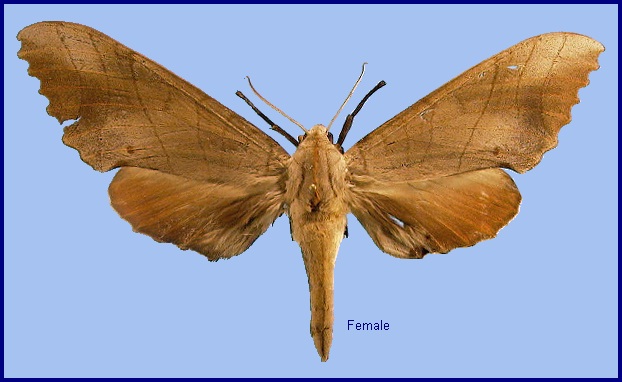
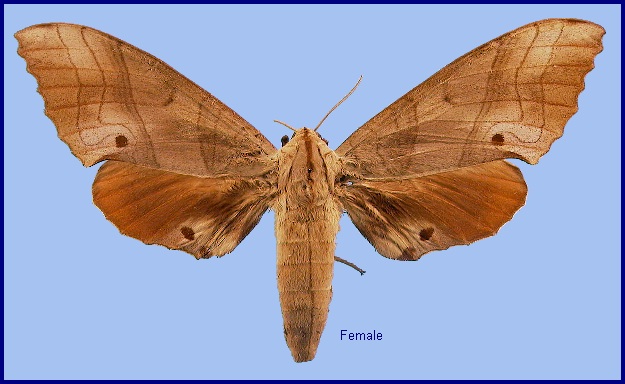

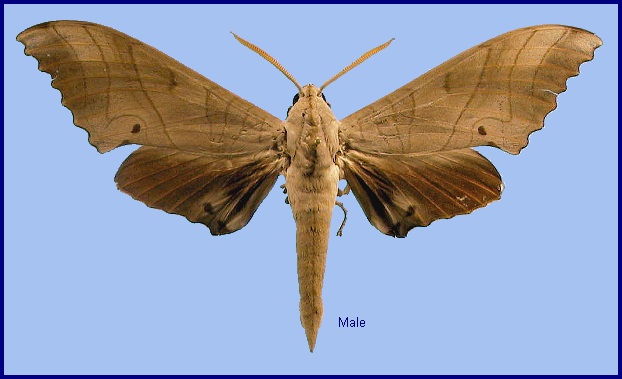
Smerinthus sperchius Ménétriés, 1857, Enumeratio Corporum Anim. Mus. imp. Acad. Sci. Petropolitanae (Ins. Lepid.) 2 (Lepid. Heterocera): 137. Type locality: Japan.
Synonym. Smerinthus sperchius Ménétriés, 1857.
Synonym. Triptogon albicans Butler, 1875.
Synonym. Triptogon gigas Butler, 1875.
Synonym. Triptogon piceipennis Butler, 1877.
Synonym. Smerinthus michaelis Oberthür, 1886.
Synonym. Marumba scotti Rothschild, 1920.
Synonym. Marumba sperchius handelii Mell, 1922.
Synonym. Marumba sperchius ochraceus O. Bang-Haas, 1927.
Synonym. Marumba sperchius ussuriensis O. Bang-Haas, 1927.
Synonym. Marumba sperchius horiana Clark, 1937.
Synonym. Marumba sperchius castanea O. Bang-Haas, 1938.
Synonym. Marumba sperchius coreanus O. Bang-Haas, 1938.
Synonym. Marumba sperchius obsoleta O. Bang-Haas, 1938.
Synonym. Marumba sperchius koreaesperchius Bryk, 1946.
[Further details on this species in Japan, as well as photos of many stages, can be found on Digital Moths of Japan as well as Moths of the southern Shikoku, Japan.]
Wingspan: 88--138mm. Similar to Marumba juvencus, but the lines of the forewing and the ground colour of the hindwing are more reddish and the lines on either side of the weak discal spot hardly converge, whereas they converge distinctly in M. juvencus. Forewing underside with tornus suffused with rufous; unlike situation in M. juvencus and M. tigrina the apex is not dark brown. Hindwing underside with lines much less sinuous than in M. juvencus and M. tigrina.
In the male genitalia, uncus rounded at sides, not deeply divided and with resulting sinus narrow, lobes notched. Gnathos narrow, long. Valva with dorso-apical lobe dagger-shaped; processes of subdorsal basal fold very long and slender. Harpe notched irregularly and with tubercles. In the female genitalia, sterigma with a rounded lobe at each side of ostium bursae.
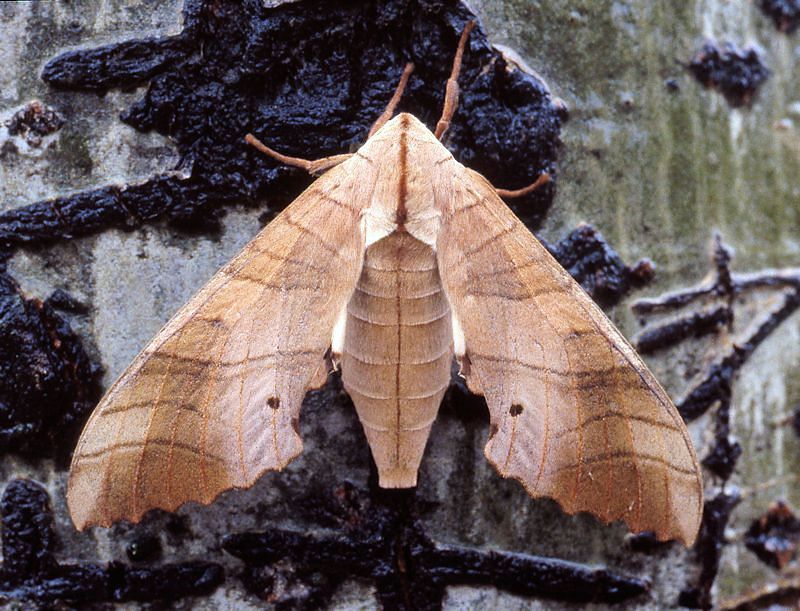
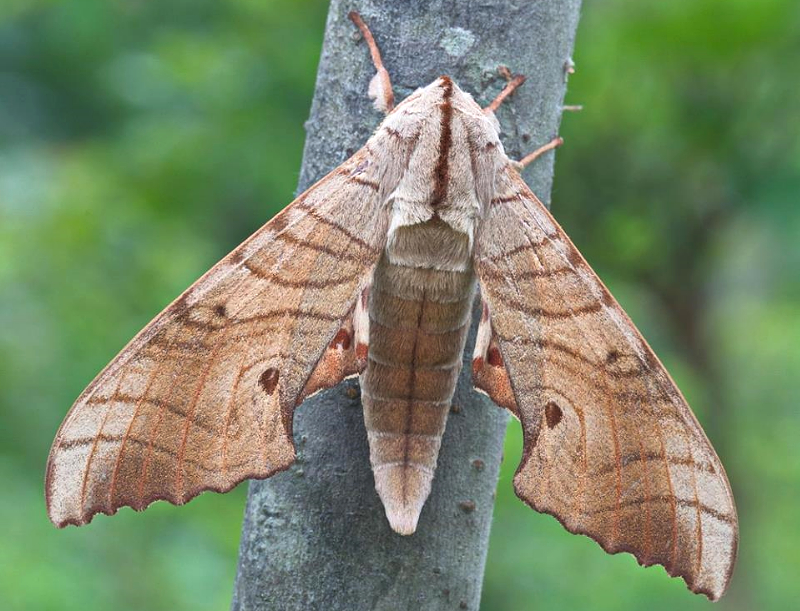
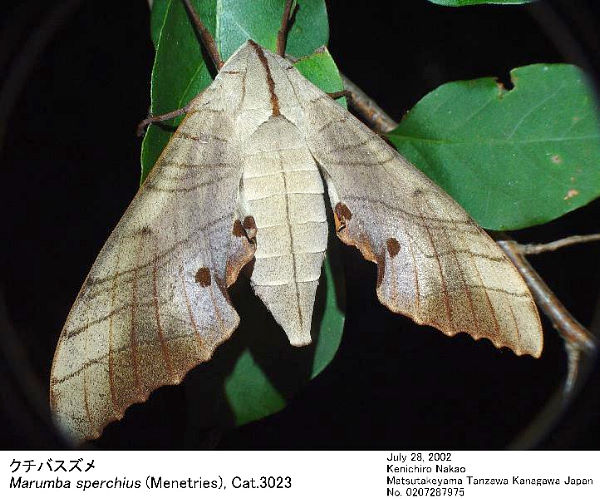
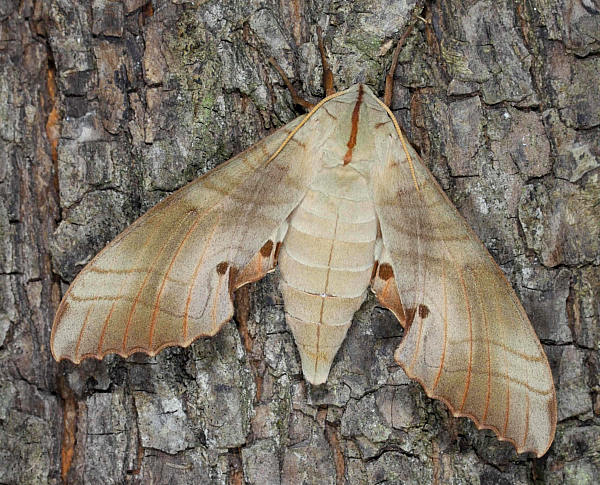

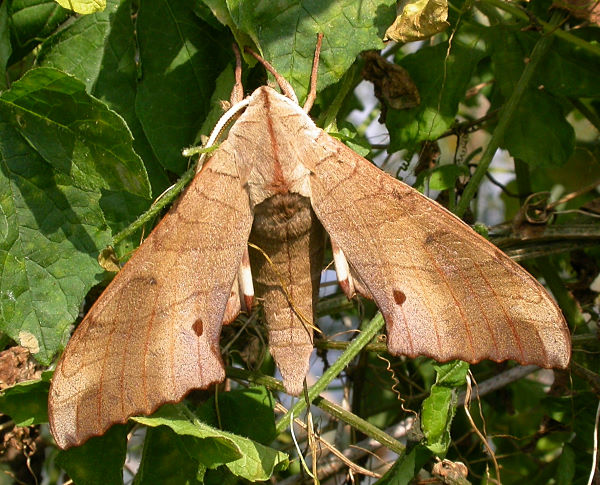
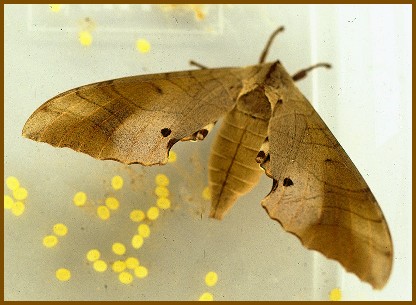
Widely distributed in Taiwan, from lowlands to high altitudes (Lin, 2000). In the Russian Far East, a lowland species of deciduous woodland characterized by Quercus mongolica (Izerskiy, 1999b).
China: 19.iii (Yunnan); 30.iii (Guangdong); 14.iv (Guangdong); v (Hunan); 14-30.vi (Nei Mongol; Jilin; Beijing); 27.vi (Yunnan); vi (Sichuan; Guangdong); vi-vii (Zhejiang); vii (Nei Mongol; Heilongjiang; Guangdong; Beijing); 12.vii (Shaanxi); 5.viii (Liaoning); viii (Fujian; Guangdong); ix (Sichuan; Shaanxi). Taiwan: iii-v (Kaohsiung Hsien; Nantou Hsien); v-vi (Nantou Hsien); vii (Nantou Hsien); ix (Hualien Hsien). North Korea: vi (Sinmi-do); vii (Musan). Japan: 29.v-1.viii (Honshu); 15.vi (Shikoku); 15-25.vii (Hokkaido). Russia: 7.vi-19.vii (Khabarovskiy Krai); 3.vii-8.viii (Primorskiy Krai).
In northern China there are two generations per year, with adults flying in April and August (Yang, 1978).
Park et al. (1999) give late May until late August as the flight period in Korea.
OVUM: Laid singly, oval, 1.8 x 1.5 mm, pale yellow, turning greenish brown with red stripes before hatching in 7-9 days; chorion not eaten (Lin, 2000).
LARVA: Full-fed 72--120mm. First instar larvae (L1) with head and body pale yellow, 5 mm in length, horn pink, about 1 mm; lasting about 4 days. Second instar larvae (L2), head and body green with many yellowish, tiny granules, head with violet protrusion, about 1 mm long, body length 18 mm, horn about 4 mm, violet red with terminal 1/4 yellow, lasting 4 days. Third instar larvae (L3), head and body green, head with red, pointed protrusion about 2 mm, body length about 26 m, horn dark green, about 5 mm, lasting 7 days. Fourth instar larvae (L4) head and body green, head with violet red protrusion, about 2 mm, body length about 28-30 mm, horn brown, 8 mm, body lateral with oblique yellow band, lasting 5 days. Fifth instar larvae (L5) head and body green, lateral with oblique white lines, head triangular, with short blackish red horn, body length 36 mm, horn 8 mm, blackish red with terminal 1/3 yellow, lasting 7 days. Last instar larvae (L6) head and body green, head triangular with pointed protrusion; face yellow whitish. First and fifth abdominal segments lateral with oblique white line, the other abdominal segments lateral with gray line; horn 12 mm. Body dorsal pink before pupation, lasting 13 days. Hatching to pupa 47 days, prepupa to pupa 8 days (Lin, 2000). [Further details are given by Eitschberger & Nguyen (2018).]
Bell & Scott (1937) noted that in India (Khasi Hills) larvae were often found with numbers of small black flies sitting on them, but that they did not appear to cause any ill effects.
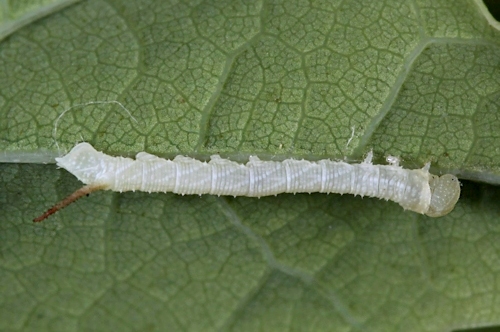
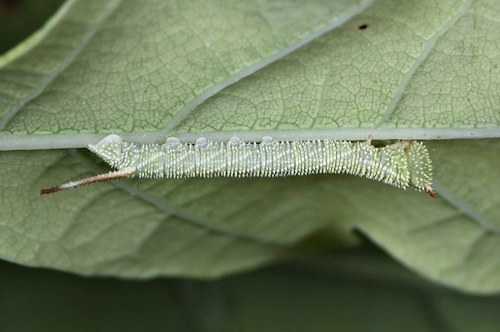
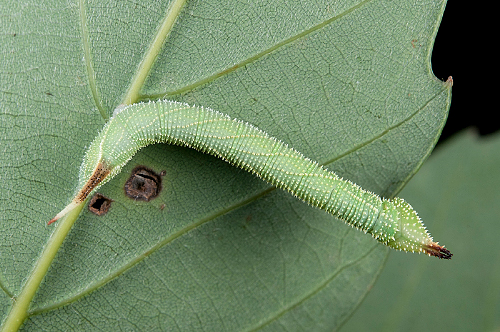
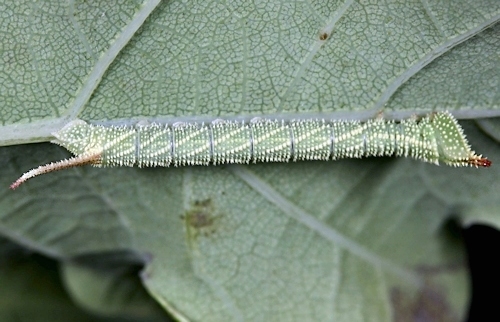
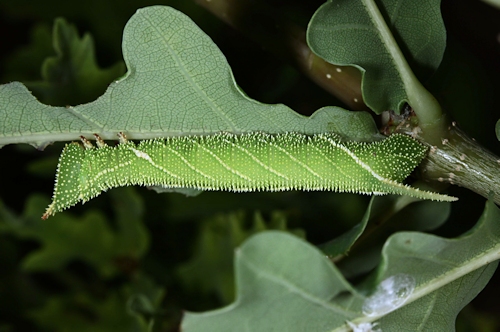
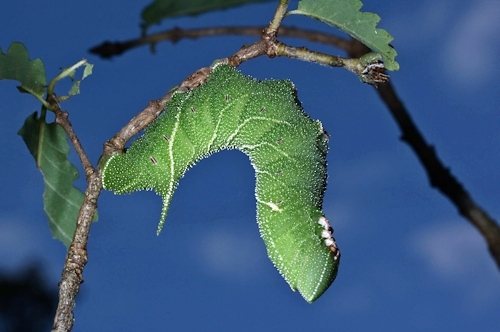
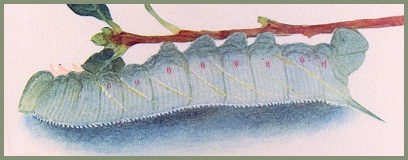
PUPA: 40--61mm. Fuscous; frontal area porrect; base of clypeus with pointed processes; abdomen glossy ventrally, dorsal surface moderately rugose, tapering anteriorly. Overwinters as pupa (Lin, 2000).
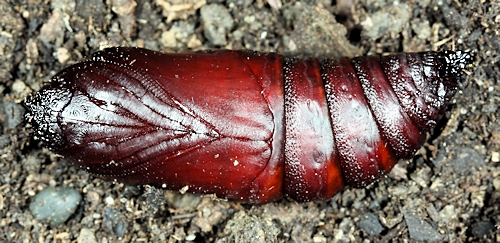
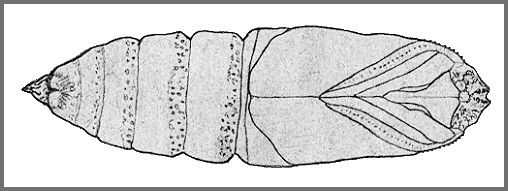
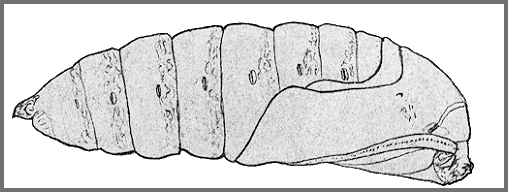
Larval hostplants. In Shanxi, China, reported from Juglans regia and Castanea (Li & Guo, 1990); however, in India this species has only been recorded from Quercus (Bell & Scott, 1937).
In Taiwan mainly on Quercus glauca [syn. Cyclobalanopsis glauca] (Lin, 2000); also Ficus microcarpa and Lithocarpus konishii.
Recorded in Primorskiy Krai, Russia, on Juglans mandschurica (Derzhavets, 1984) and Quercus mongolica (Izerskiy, 1999b). The latter also from Amurskaya (Streltzov, Osipov & Malikova, 2003).
In Japan, recorded from Castanea crenata, Lithocarpus edulis, Quercus acutissima, Quercus glauca and Quercus myrsinaefolia.
Recorded in Korea on Quercus acuta, Quercus salicina, Quercus acutissima, Quercus serrata and Castanea crenata (Park et al., 1999).
Ichneumonidae: Amblyjoppa cognatoria (Smith, 1874). Tachinidae: Exorista sorbillans (Wiedemann, 1830).
China: Nei Mongol (Chifeng/Ulanhad, Daguangdingzishan, 2061m; Hulunbuir Region, Sanhaodian); Heilongjiang (Zhaodong); Jilin (Jiaohe, Lafa Shan); Liaoning (Changhai, Dachangshan Island; Qingchengzizhen, Fengcheng); Hebei; Beijing (Baihua Shan; Badaling National Forest Park); Shanxi (Taigu; Jiexiu; Wenshui; Xiaxian); Shaanxi (Huangling; Taibai Shan, 3000m; Xunyang, 1380m; Jinsuoguanzhen, Yintai District, Tongchuan); Henan (Niuxinduo Shan, nr. Luoyang, 1763m); Anhui (Mt. Huang Shan); Zhejiang (Tianmu Shan; Kuocang Mountain Nature Reserve); Hubei (Luotian); Sichuan (Baoxing; ??Mt Pehlinling, 6000'); Yunnan (Kunming; Pingbian Co., Dawei Shan Nature Reserve, 2000m; Simao/Pu'er; Weixi); Guizhou (Xinzhaidashan, Zhijin County, 1000-2000m); Hunan (Wenxing Village); Fujian (Guangze, 1200m; Longqi Shan); Guangdong (Longtou Shan; Nanling National Forest Park, 1100m (Morishita & Kishida, 2000); Zhuhai).
Taiwan: Hualien Hsien (Taroko National Park; Hungyeh); Nantou Hsien (Puli; Fushih Spa, 1200m; Chunyang; Nansanchi; Renluen, 1400m; Lushan Spa); Kaohsiung Hsien (Shanping, 640m); Taipei Hsien (Fushan); Yilan Hsien (Fushan Botanical Garden, 700m); Taichung Hsien (Kukuan).
North Korea: Kangwon Province (Keumgang-san); South Hamgyong Province (Seokwang Temple; Nangnimsan); North Hamgyong Province (Musan, 1200m; Jueul); North Pyongan Province (Sinmi-do).
South Korea: Baengnyeong-do & Daecheong-do; Seoul; Kyonggi Province; Kangwon Province; North Chungchong Province; South Chungchong Province; North Cholla Province; South Cholla Province; North Kyongsang Province; South Kyongsang Province; Cheju Province
Japan: Hokkaido; Honshu (Tokyo; Asamayama; Mukoyama; Nikko; Yokohama; Kobe; Chiba; Nashimoto; Kumanotaira; Mikaboyama, 750m; Yunotaira Spa; Bushi; Mitsumine; Tanzawa; Akashina; Oki Islands); Shikoku (Kochi); Kyushu (Nagasaki); Tsushima (Izuhara); Tanegashima; Ryukyu Archipelago (Okinawa).
Russia: Amurskaya (Blagoveshchensk; Uril area); Yevreyskaya (Bastak); Khabarovskiy Krai (Bolshekhekhtsyrskii Nature Reserve, Khabarovsk suburbs); Primorskiy Krai (Andreevka; Khasan; Ussuriysk; nr. Vladivostok; Narva; Kedrovaya Pad Nature Reserve; Vityaz Bay; near Kalinovka; near Zanadvorovka); Kurile Islands (Kunashir Island); Sakhalin Island.
From northern Pakistan (Murree) (Rafi et al., 2014), northern India, Nepal, Bhutan (Dierl, 1975; Irungbam & Irungbam, 2019), southwestern, central and eastern China to the southern Russian Far East, North Korea, South Korea and Japan. Also south to continental Thailand, Laos and central Vietnam (Eitschberger & Nguyen, 2018; Le & Vu, 2024).
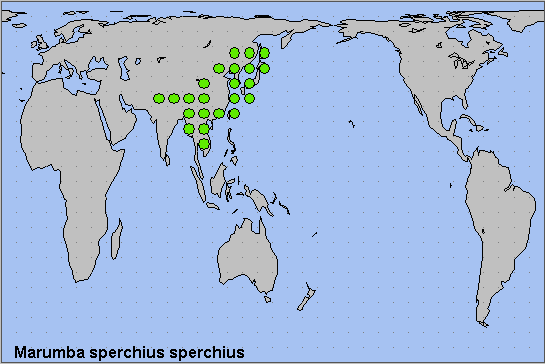
 Return to Sphingidae of the Eastern Palaearctic species list
Return to Sphingidae of the Eastern Palaearctic species list